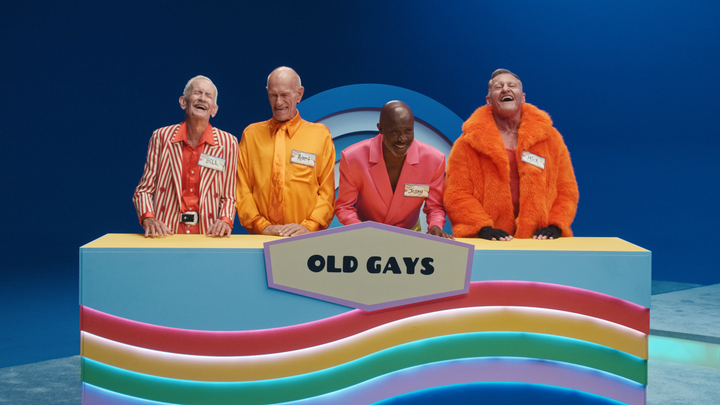
Even during our officially designated month of celebration, queer people are grappling with anti-trans laws in the South and essentially every form of homophobia you can name. The Human Rights Campaign recently declared a state of emergency in the U.S. for LGBTQ+ people. So, yes, parades and parties are great and they’ll get us through the month, but what about the reality that many of us are trying to figure out how to survive and thrive in our daily lives?
I decided to seek out wisdom from our collective queer daddies — aka the Old Gays — on how to build sustainable queer joy.
Robert Reeves, Mick Peterson, Bill Lyons and Jessay Martin, known on social media as the Old Gays, are four queer elders living their best lives. They reside together in a gorgeous home in Palm Springs, California, and make inspiring content full of singing, dancing and drag.
It sounds idyllic, right? It really is, they assure me. But their lives haven’t always been this sweet. “I wish they knew what we went through,” Martin says of younger queer people.
The Old Gays recently appeared on “No Straight Answers” ― a YouTube game show presented by Visible, a digital wireless service owned by Verizon ― where they were pitted against a team of young queer people in a battle to see who knew the most queer history. No spoilers here, but all the Old Gays agree that one of the first steps to happiness is knowing queer history.
But because our history isn’t often taught in schools, learning about the struggles of queer folks throughout time requires effort. Several queer history podcasts and books have arrived in the past few years, which has been a major help. But to really understand the nuanced experiences of our queer elders, we need to talk to them. “Take our oral histories while we’re alive,” says Peterson.
Lyons says that knowing about the struggles of the past may help us deal with current circumstances and give us more hope for the future. The Old Gays, for example, didn’t just survive one of the most harrowing moments in gay history — the AIDS crisis in America — they’ve gone on to become indisputable icons.
Peterson tells me that one good thing that came out of the tragedy of the AIDS crisis was the galvanisation around it. “The greater population started seeing us for who we were and seeing our courage,” he says. The AIDS crisis was arguably the first time in history that gay people and allies were in the public eye in record numbers fighting for gay rights — and gay lives.
It’s terrifying that it took the deaths of so many to turn the tide of public opinion in our favour, but it did. Talking to people who lived through that history is a reminder that no matter how bleak things seem, we can move through them into beautiful futures, says Reeves.
While the Old Gay men are horrified by the current anti-trans and anti-queer legislative shit show, they have perspective. They’ve seen this type of hate up close before.
“The tactics that the right-wing movement is using are going to come back to bite them,” Lyons says. “They are demonstrating how ugly they are willing to be, and more and more people are going to see that for what it is. You’re going to see us get stronger when we get past this.”
The truth is, no history book can give us the kind of reassurance we need right now. We need to look in each other’s eyes and hear each other’s stories. “I would like young people to understand what we had to go through when we came out,” Lyons says. Understanding the emotional resilience of those who came (out) before us is an honour ― and it’s our responsibility as people who will have to pass along that knowledge in turn.
For queer people, empowerment often goes hand in hand with bodily freedom and sexual liberation. Still, some of us need to hear this: Connecting with queer elders doesn’t mean just hooking up with people older than you. Peterson says that, while many of his recent sexual partners have been under 40, bonding on a physical level isn’t enough. “There’s a real need for the younger generations to connect beyond a sex encounter,” he says.
The popularity of the Old Gays and their status as elite queer influencers suggests we’re all seeking a more expansive multigenerational connection. “People really love when we post about looking back,” Reeves says. “They want to know more.”
Queer people and events have largely been left out of history. Sometimes that omission has been a deliberate act of erasure, but other times the events themselves were simply happening behind the scenes or on a local level. “Before Stonewall, I don’t think there was any main newsworthy event,” Reeves tells me. “It was more what was happening locally. The gay community was being depressed by local law enforcement that would try to tap down on any kind of gay activity. It wasn’t until the ’70s that things started getting newsworthy.”
Knowing about those smaller happenings is, in some ways, just as important as knowing the broad strokes. This is not ancient history — these are the experiences of our living queer elders, and all you have to do to know more is ask. Learning queer history is more like studying the genealogy of family than studying the rise and fall of civilisations. And that seems fitting, since for a lot of queer people, community and family go hand in hand.
That’s another gem that the Old Gays want to pass on to younger gays. “What you need to do is develop friendships that are a repertoire of family,” says Peterson. “They may be with you for the rest of your life. Build those relationships on trust and love and recognise each other in the struggles.”